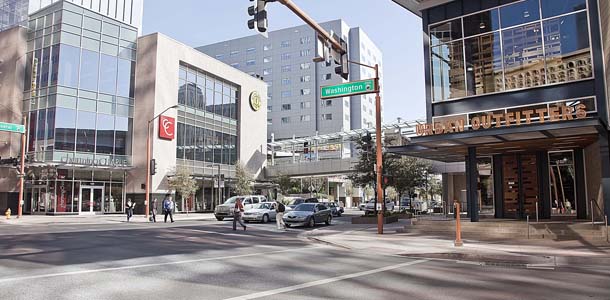BOMA Phoenix this week named RED Development’s CityScape Phoenix office tower the winner of The Kilowatt Crackdown Award for the most improved ENERGY STAR benchmarked building above 500,000 square-feet in the Greater Phoenix area for 2013.
A highly regarded award, ENERGY STAR measures energy savings using the U.S. Environmental Protection Agency (EPA)’s standards and it is a voluntary program that helps businesses and individuals save money and protect the climate through superior energy efficiency.
Cityscape Phoenix won the award based on its EPA ENERGY STAR rating that improved from 81, which is considered above the national average, to 97 through the 2013 calendar year. A minimum score of 75 is required by EPA to be certified and a score of 81 placed CityScape above average for all US buildings certified. This previous certified score was achieved by RED’s design choices and selection of LEED compliant construction materials of the decisions made during the development phase of the project allowed for the enhanced operations. The score of 97 puts the CityScape Phoenix tower in the top three percentile of all buildings in the U.S.
“RED made the decision to pursue a higher ENERGY STAR rating for the office tower for a variety of reasons including to lower operating costs, reduce greenhouse gas emissions, increase the asset’s value and to fulfil a higher standard of corporate environmental responsibility. Over the past few years, more of our office tenants require sustainable buildings and we are proud to be in the nation’s top percentile,” said Ron Roeske, general manager of CityScape Phoenix.
The work mainly consisted of evaluating all existing aspects of the building’s mechanical systems and verifying each piece of equipment meet the design intent. Upon completion of the mechanical audit the building control system was then evaluated and defined. After these systems were verified, mechanical and control system deficiencies were modified and corrected as required. These corrections were routinely physical repairs and adjustments to non-functioning hardware and mechanical equipment.
“The process was a lengthy one and was performed with occupant comfort and feedback being a constant consideration. Our CityScape engineering team provided all of the services without the assistance of an outside firm, which was a notable accomplishment,” said Al O’Connor, Corporate Engineer, who led the ENERGY STAR improvement initiatives.
The final, and most productive, component of this work was system integration and optimization of the building automation system (BAS) with the mechanical equipment. Several information metrics including building use, lease requirements, utility trend and pulse report data, local temperature bin and operation history were evaluated. This information was then used to optimize building operations, through programming and schedules, to achieve optimal improvements in energy consumption.
Since 1992, EPA has worked with organizations to help them save money and reduce greenhouse gas emissions by making their buildings and plants more energy efficient. Every year, they’re saving more than $9 billion and preventing nearly 120 million metric tons of greenhouse gas emissions from entering the atmosphere.




